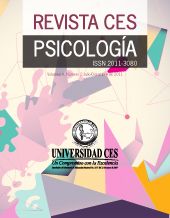SUICIDIO Y TRASTORNO MENTAL (Suicide and Mental Disorder)
Resumen
La Organización Mundial de la Salud define el suicidio como el acto deliberado de quitarse la vida, causándose una lesión, con un grado variable en la intención de morir. El suicidio es la cuarta forma de muerte violenta en Colombia (Cifuentes, 2013). En el 2014 se reportaron 4,33 casos por 100.000 habitantes, siendo los grupos etarios de 20 a 24 y de 70 a 74 años los que presentan mayores tasas a nivel nacional (Ramírez & Naranjo, 2014). La literatura reporta que en el 90% de casos de suicidio se encuentra algún trastorno mental asociado; lo que se constituye en un problema de salud pública. Este artículo de revisión se propone describir la relación entre trastornos mentales y conducta suicida, con el fin de contribuir al entendimiento del fenómeno y resaltar la necesidad de crear e implementar estrategias de atención temprana.
Palabras Clave: Suicidio, Ideación Suicida, Salud Mental, Salud Pública, Psicopatología, Trastorno Mental.
Abstract
The World Health Organization defines suicide as the act of deliberately killing oneself, causing injury or damage, with varying degrees of intention to die. Suicide is the fourth form of violent death in Colombia. In 2014, 4.33 cases per 100,000 inhabitants were reported; the target age groups, with the higher rates nationwide, consisted of 20-24 and 70-74 years old. Papers reported that 90% of suicides are associated with mental disorder therefore, it should be considered a public health problem. This study aims to review scientific literature to describe the relationship between mental disorders and suicidal behavior, highlighting the need to establish and implement strategies for early intervention in populations at suicide risk.
Key Words: Suicide, Suicidal Ideation, Mental Disorders, Mental Health, Public Health, Psychopathology.
Descargas
Referencias bibliográficas
Amalsadvala T, Swaim SF. Management of Hard-to-Heal Wounds. Vet Clin North Am Small Anim Pract. 2006 Jul;36(4):693–711.
Szpaderska AM, Egozi EI, Gamelli RL, DiPietro LA. The effect of thrombocytopenia on dermal wound healing. J Invest Dermatol. 2003 Jun;120(6):1130–7.
Kulidjian AA, Inman R, Issekutz TB. Rodent models of lymphocyte migration. Semin Immunol. 1999 Apr;11(2):85–93.
Esche C, Stellato C, Beck LA. Chemokines: key players in innate and adaptive immunity. J Invest Dermatol. 2005 Oct;125(4):615–28.
Gillitzer R, Goebeler M. Chemokines in cutaneous wound healing. J Leukoc Biol. 2001 Apr;69(4):513–21.
Weiss SJ. Tissue destruction by neutrophils. N Engl J Med. 1989 Feb 9;320(6):365–76.
Issekutz AC, Chuluyan HE, Lopes N. CD11/CD18-independent transendothelial migration of human polymorphonuclear leukocytes and monocytes: involvement of distinct and unique mechanisms. J Leukoc Biol. 1995 Apr;57(4):553–61.
Nagaoka T, Kaburagi Y, Hamaguchi Y, Hasegawa M, Takehara K, Steeber DA, et al. Delayed wound healing in the absence of intercellular adhesion molecule-1 or L-selectin expression. Am J Pathol. 2000 Jul;157(1):237–47.
Trautmann A, Toksoy A, Engelhardt E, Bröcker EB, Gillitzer R. Mast cell involvement in normal human skin wound healing: expression of monocyte chemoattractant protein-1 is correlated with recruitment of mast cells which synthesize interleukin-4 in vivo. J Pathol. 2000 Jan;190(1):100–6.
Eming SA, Krieg T, Davidson JM. Inflammation in Wound Repair: Molecular and Cellular Mechanisms. J Invest Dermatol. 2007 Mar;127(3):514–25.
Bayat A, McGrouther DA, Ferguson MWJ. Skin scarring. BMJ. 2003 Jan 11;326(7380):88–92.
Diegelmann R., Evans MC. Wound healing: an overview of acute, fibrotic and delayed healing. Front Biosci. 2004;9:283–9.
Fowler D. Distal Limb and Paw Injuries. Vet Clin North Am Small Anim Pract. 2006 Jul;36(4):819–45.
White RAS. Management of Specific Skin Wounds. Vet Clin North Am Small Anim Pract. 2006 Jul;36(4):895–912.
Scott DW. Bacterial skin disease. Muller & Kirk’s small animal dermatology. 6th ed. Philadelphia: W.B. Saunders; 2001. p. 274–335.
Rafanelli A, Saponati G, Rafanelli S. Eficacia y tolerabilidad del Fitostimoline gasas en el tratamiento epicutáneo de lesiones distróficas ulceradas de la piel y del retardo en la cicatrización.
Coutiño Mata JJ, Cuenca Pardo JA, Álvarez Díaz C de J, Villaseñor Ferreira A. Manejo de áreas donadoras de injertos de piel tratadas con gasa con Triticum vulgare vs gasa con petrolato. Cir Plástica. 2002;12(2):61–4.
Solórzano OT. Evaluación de la actividad reepitelizante del Triticum vulgare en la cervicitis crónica erosiva. Rev Faculdad Med-UNAM. 2001;44(1):79–83.
Méndez MV, Stanley A, Park HY, Shon K, Phillips T, Menzoian JO. Fibroblasts cultured from venous ulcers display cellular characteristics of senescence. J Vasc Surg. 1998 Nov;28(5):876–83.
Wlaschek M, Peus D, Achterberg V, Meyer-Ingold W, Scharffetter-Kochanek K. Protease inhibitors protect growth factor activity in chronic wounds. Br J Dermatol. 1997 Oct;137(4):646.
Wenk J, Foitzik A, Achterberg V, Sabiwalsky A, Dissemond J, Meewes C, et al. Selective pick-up of increased iron by deferoxamine-coupled cellulose abrogates the iron-driven induction of matrix-degrading metalloproteinase 1 and lipid peroxidation in human dermal fibroblasts in vitro: a new dressing concept. J Invest Dermatol. 2001 Jun;116(6):833–9.
Dernell WS. Initial Wound Management. Vet Clin North Am Small Anim Pract. 2006 Jul;36(4):713–38.
Krahwinkel DJ, Boothe HW. Topical and Systemic Medications for Wounds. Vet Clin North Am Small Anim Pract. 2006 Jul;36(4):739–57.
Hosgood G. Stages of Wound Healing and Their Clinical Relevance. Vet Clin North Am Small Anim Pract. 2006 Jul;36(4):667–85.
Amsellem P. Complications of Reconstructive Surgery in Companion Animals. Vet Clin North Am Small Anim Pract. 2011 Sep;41(5):995–1006.
Mandelbaum SE, Di Santis E, Mandelbaum MH. Cicatrização: conceitos atuais e recursos auxiliares - Parte II. An Bras Dermatol. 2003;78(5):365–0596.
Campbell BG. Dressings, Bandages, Splints for Wound Management in Dogs and Cats. Vet Clin North Am Small Anim Pract. 2006 Jul;36(4):759–91.
Vanden Berghe DA, Yang QR, Totté J, Vlietinck AJ. Specific stimulation of human endothelial cells byTriticum vulgare extract and its biologically active fraction. Phytother Res. 1993 Mar;7(2):172–8.
Farinella Z, Morale MC, Agosta MA, Rizza V. Stimulation of cell division in mouse fibroblast line 3T3 by an extract derived from Triticum vulgare. Int J Tissue React. 1986;8(4):337–42.
Tillmann M. Antisépticos e Fitoterápico na cicatrização de feridas [Dissertação]. [Pelotas]: Universidade Federal de Pelotas; 2011.
Galera PD, Almeida Falcão MS, Ribeiro CR, Viana Valle AC, Laus JL. Utilization of the aqueous extract of triticum vulgare (bandvet®) after superficial keratectomy in domestic cats afflicted with corneal sequestrum. Ciênc Anim Bras. 2008;9(3):714–20.
Lima de Andrade A, Rui Luvizotto MC, Sakamoto SS, Brêda Souza T, Rodrigues Fernandes MA. Eficácia do extrato aquoso do Triticum vulgare no tratamento de radiodermatites geradas pelo uso da radioterapia em gatos. Arch Vet Sci. 2010;15(3):135–42.
Souza D, Machado T, Zoppa A, Cruz R, Garague A, Silva L. Ensaio da aplicacao de creme a base de Triticum vulgare na cicatrizacao de feridas cutaneas induzidas em equinos. Rev Bras Plantas Med. 2006;8(3):9–13.
Ribas LM, Nogueira CE., Beira FTA, Albuquerque LPAN, Kickhofel I. Efeito cicatrizante do extrato aquoso de Triticum vulgare em feridas do tecido cutâneo de equinos. Hora Veterinária. 2005;25(147):27–9.
Paganela JC, Ribas LM, Santos CA, Feijó LS, Nogueira CEW, Fernandes CG. Abordagem clínica de feridas cutâneas em equinos Clinical approach in equine skin wounds. Rev Port Ciênc Veterinárias. 2009;(104):569–72.
Gurgel Godeiro JR, Soares Batista J, Fernandes P, Albornoz RE, Amorim RL, Barbosa Calado E, et al. Avaliação da atividade cicatrizante de creme à base de Triticum vulgare em feridas cutâneas de gatas submetidas à ovariossalpingohisterectomia. Acta Vet Bras. 2010;4(2):78–85.
Descargas
Publicado
Cómo citar
Número
Sección
Licencia
Revista CES Psicología ISSN 2011 3080
Facultad de Psicología, Universidad CES Primera edición 2008. Última actualización Mayo 18 de 2022. Todos los derechos reservados. Hecho el depósito legal que exige la ley.
Se autoriza la reproducción total o parcial de los artículos citando la fuente y el autor. This publication may be reproduced by mentioning the source and the authors.
| Estadísticas de artículo | |
|---|---|
| Vistas de resúmenes | |
| Vistas de PDF | |
| Descargas de PDF | |
| Vistas de HTML | |
| Otras vistas | |



